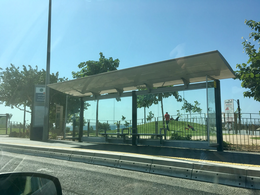
Haifa is the third-largest city in Israel—after Jerusalem and Tel Aviv—with a population of 290,306 in 2022. The city of Haifa forms part of the Haifa metropolitan area, the third-most populous metropolitan area in Israel. It is home to the Baháʼí Faith's Baháʼí World Centre, and is a UNESCO World Heritage Site and a destination for Baháʼí pilgrimage.

Transportation in Israel is based mainly on private motor vehicles and bus service and an expanding railway network. A lack of inland waterways and the small size of the country make air and water transport of only minor importance in domestic transportation, but they are vitally important for Israel's international transport links. Demands of population growth, political factors, the Israel Defense Forces, tourism and increased traffic set the pace for all sectors, being a major driver in the mobility transition towards railways and public transit while moving away from motorized road transport. All facets of transportation in Israel are under the supervision of the Ministry of Transport and Road Safety.

The Carmelit is an underground funicular railway in Haifa, Israel. Construction started in 1956 and ended in 1959. It is the oldest underground transit system in the Middle East and was the only underground transit system in Israel until the 2023 opening of Tel Aviv Light Rail. The Carmelit has closed down for repair on three occasions.

Dan Bus Company is an Israeli bus company based in Tel Aviv. It operates local bus service in the Tel Aviv Metropolitan Area.
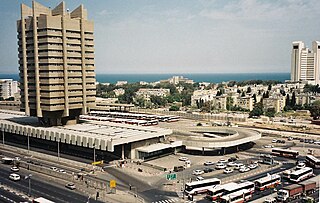
The Haifa Bat Galim central bus station was named after the Haifa neighborhood of Bat Galim. Until January 1, 2002, it served all Egged intercity bus routes originating and terminating in Haifa, as well as most local routes. The Bat Galim station was in use for about thirty years. The main building itself is a Brutalist mega-structure.
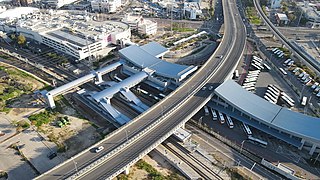
Haifa Bay central bus station, known also as HaMifratz central bus station is the main bus station of the Haifa Bay area. It is co-located with HaMifratz Central railway station and is adjacent to Lev HaMifratz Mall. It opened in 2002 and was substantially renovated and expanded in the late 2010s.

Carmel Beach central bus station is the main bus station in Haifa, Israel, replacing the Haifa Bat Galim central bus station. The former station is now only used to store Egged buses and for Egged office space and inner-city buses now only stop there on the road rather than inside on the route between Haifa Hof HaCarmel central bus station and the Mifratz central bus station. Carmel Beach central bus station opened on 19 August 2003. Since then, all buses coming from the South which formerly ended at Haifa Bat Galim central bus station terminate at Carmel Beach central bus station and new more frequent lines operate between the three stations. Passengers can get a free transfer to urban buses when they buy their inter-city ticket to continue from one central bus station to the other one, or into the city.

Nahariya railway station is a railway station serving the city of Nahariya, Israel, and the surrounding towns and villages of the Western Galilee region. It is the northernmost passenger station in Israel and is currently the terminus of the north–south coastal line.
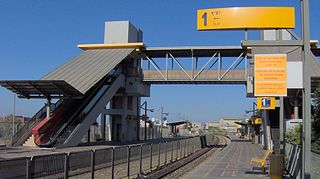
HaMifratz Central railway station is an Israeli railway passenger station in Haifa, Israel co-located with the Haifa Bay central bus station. It serves Lev HaMifratz Mall, one of Haifa's largest malls, and the surrounding Haifa Bay industrial zone in the northeast of the city.

Haifa Center–HaShmona railway station is an Israel Railways passenger station situated on the coastal railway main line and serves the City of Haifa.

Haifa–Bat Galim railway station is an Israel Railways passenger station situated on the coastal railway line and serves the city of Haifa. The station takes its name from the neighborhood of Bat Galim, where it is located. The station was Haifa's main train station from its construction in 1975 until the early 2000s.

Hadar HaCarmel is a district of Haifa, Israel. Located on the northern slope of Mount Carmel between the upper and lower city overlooking the Port of Haifa and Haifa Bay, it was once the commercial center of Haifa.
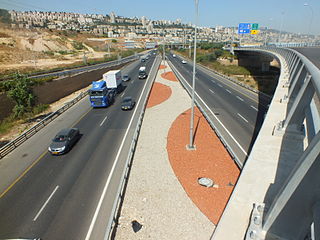
Highway 22, also known as the Bay Highway, is a suburban freeway in the Haifa metropolitan area connecting downtown Haifa with the city's northern exit to the Krayot. From there it continues northwards as a bypass of the Krayot, providing an alternative route to Highway 4.

The Bat Galim cable car is tourist cable car running up and down the mountain from the top of the Carmel, across from the Stella Maris Carmelite Monastery, to Bat Galim, with views of Haifa Bay and its surroundings. The cable car began operating in 1986. The route is 355 meters long.

Kiryat Haim is a neighborhood of Haifa. It is considered part of the Krayot cluster in the northern part of metropolitan Haifa. In 2008, Kiryat Haim had a population of just under 27,000. Kiryat Haim is within the municipal borders of the city of Haifa and lies on the shore of the Mediterranean Sea.

The Krayot central bus station is a public transport terminal serving as a terminus for the Metronit bus rapid transit system, and as a station for local bus routes serving the Krayot suburbs of Haifa, Israel.
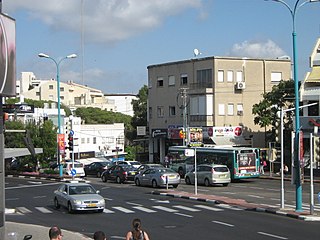
Merkaz HaCarmel also called Carmel Merkazi or in English, Carmel Center, is a neighborhood, and cultural and recreation area on the slopes of Mount Carmel in Haifa, Israel.

The Haifa–Nazareth Light Rail, known officially as Nofit, is a tram-train system under construction in northern Israel, going from HaMifrats Central railway station in Haifa to Nazareth. The system is slated to open in 2027 and have a daily ridership of 100,000 passengers.

Na'im Busofash is an Israeli weekend public transportation array that exists in 12 authorities in Gush Dan and outside of it – Givatayim, Kiryat Ono, Ramat HaSharon, Tel Aviv-Yafo, Shoham, Modi'in, Hod HaSharon, Kfar Saba, Mevaseret Zion, Ness Ziona, Herzliya, and Ra'anana.

The Rakavlit, a diminutive of רכבל, meaning cable car, and itself a contraction of רכבת, train, and כבל, cable), is a gondola lift that is a part of Haifa's expanded public transport system complementing the existing city bus and Metronit BRT lines.


